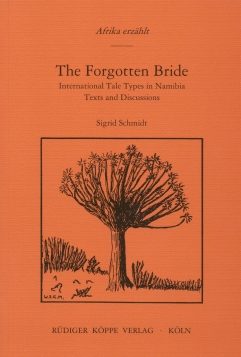


Namibia is a treasure house of folklore traditions. Until recently Nama and Damara grandmothers told a great variety of folktales. Most people will be surprised to learn that besides ancient African trickster tales, tales of magic and animal tales, the Namibian grandmothers tell many tales like Cinderella and Snow White. What is most exciting: the grandmothers did not read them in books but learned them from their grandmothers, who, in turn, had learned them from their grandmothers.
The author, who has published nine volumes of various Namibian traditions in this series, devotes this volume to the amazingly great group of tales which came orally from Europe or Asia. In part I she offers 62 stories, mainly collected by herself between 1960 and 1999, which have not been published before.
The Brother and the Fifth Daughter of the Man-eater / The Forgotten Bride / The Stolen Baby / The Son with a Moon on His Breast / The Mother Who Killed Her Own Son / The Orphan Boy, His Calf and the Princess / The Strong Man / The Magic Horse / The Grateful Dead / The Maiden Without Hands / The Pretty Little Bird / The Magic Mirror / The Talkative Wife / The Princess Who Cannot Solve the Riddle / The Boy Who was not Born / Food Without Salt / Love Like Salt / The Abandoned Daughter / Lousegirl / The Two Travelers / The Son of the Poor Fisherman / The Fisherman’s Son and the Daughter of the Devil / The Boy, His Faithless Sister and Seven-Heads / Brother and Sister and the Tying-up Game / The Man Who Understood Animal Languages / The Princess Who was Stolen by the Man-eaters / The Young Boy and Seven-Heads / The Battle Against Flying Heads and Burning Pieces of Wood / The Young Boy and the Two Man-eaters / The Two Man-eaters at the Water Pool / The Poor and the Rich Girl and the Ten Angels / The Cold and the Good and the Naughty Girl / The Robber Under the Bed / The Five Skillful Men / The Twin Brothers / The Two Brothers and the Snake Woman Letaskéya / The Brother Who was Caught in the Net of the Spider / The Woman Who Opened the River, Her Son and Seven-Heads’ Daughter / The Chicken Girl / The Speaking Horse / The Brave Little Boy and the Six-Headed Snake / Genovefa / The Girl Who Sat in the Ashes / One-Eye, Two-Eyes, Three-Eyes, Four-Eyes / The Youth Who Wanted to Learn What Fear is / The Silly Man Who had to Learn What Fear is / The King and His Shepherd / The Clever Answer / The Grateful, Helpful Animals / The Three Strong Men and the Devil (I) / The Three Strong Men and the Devil (II) / The Rich Visitor / The Cripple Boy and the King’s Daughter / The Prophecies of the Man-eater / Longleg, Farseer and Oceandrinker / The Man Who did not Believe in Ghosts / The Shepherd and His Visitor / The Dead Bridegroom / The Poor Nama Shepherd and the Rich White Farmer / The Boy and His Cat / The Handkerchief / The Poor Woman and Her Donkey / The King’s Dream.
Part II gives the background information on the narrators, part III a study of the history and character of 48 individual tale types and a general discussion of the fate of the originally European and Asian tales in Southern Africa.
Most of these tales were brought to South Africa in the 17th and 18th centuries, were adopted and adapted by the Khoekhoe already at that early time and, mainly in the 19th century, wandered with them to Southwest Africa / Namibia. During this long period the originally European and Asian tales turned into Nama and Damara tales.
Part IV adds the tools for a closer study: analysis of all existing variants of this group of tales (ATU 300-999), motif index according to Stith Thompson, subject index and a survey of the Afrikaans tales of magic.
Following the link at the bottom, you will find the full review text by Christine Goldberg.
In her Catalogue of the Khoisan Folktales of Southern Africa, re-edited in 2013, Sigrid Schmidt lists all tales which were told by Khoisan people and said to have been learned orally. The catalogue consists of two volumes that can be ordered separately or together, see the following links:
Von großem Gewinn für die internationale Typen-, Stoff- und Motivforschung und eine gelungene Ergänzung des ATU ist der im vierten Teil vorgestellte Anhang [...] mit einem für Gesamtafrika detailliert strukturierten Typenkatalog, der Erzähltypen einschließt, die im vorliegenden Band nicht behandelt werden [...], sowie Ergänzungen und Korrekturen zu bereits bestehenden südafrikanischen Typenkatalogen [...], eine Typenkonkordanz und ein Motiv- und Sachverzeichnis enthält.
Hans-Jörg Uther in Fabula, 51, 1/2, 2010, 168
The Forgotten Bride would work as a self-guided introduction to comparative folktale scholarship. The texts in part 1 are engaging. Part 2 identifies each tale-type number, which the reader can use in part 4 to locate a summary and corroborative texts. Then, in many cases, part 3 explains the variation in that tale type and its distribution in Namibia, Africa, and elsewhere. More experienced folktale scholars can use the book in the same way, but they will also value the glimpses it affords of folktales in the seventeenth and eighteenth centuries.
Christine Goldberg in Marvels & Tales: Journal of Fairy Tale Studies, 24/2, 2010, 345-347
© 2026 by Rüdiger Köppe Verlag – www.koeppe.de